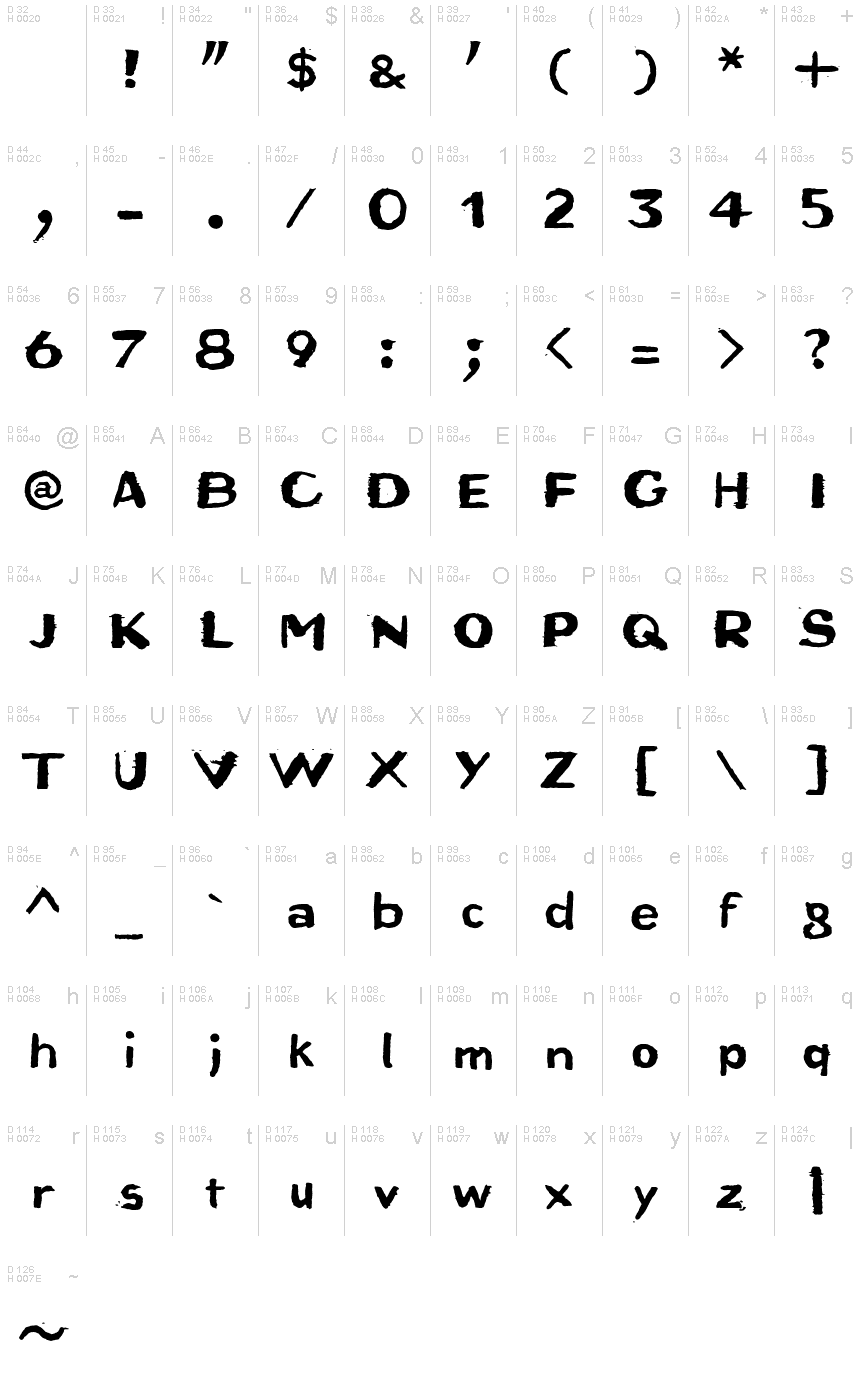Bruta Woodcut
TrueTypeFreeware
- Acentos (parcial)
- Acentos (completo)
- Euro
Bruta_Woodcut.ttf
Etiquetas
Nota del autor
Bruta Woodcut font is an eroded display font designed by Ingo Zimmermann.
An alphabet originally carved in wood
The German term for characters or letters is Buchstaben, literally Buche (beech) and Stab (rod or stick), and dates back to the Germanic custom of carving runic characters in beechwood sticks. On New Years Eve, 2014, I used the occasion to cut real beech characters myself. I carved all the characters of this font in woodcarving manner, without tracing and mirror-inverted, in smoothly planed beech rods. After printing on paper, the digital font you see here was created from the negative typeface.
Originally planning an alphabet of capital letters only, I ended up carving figures, punctuation marks and lower case letters after all. The capital letters emphasize alternation between bold and fine strokes, which is familiar in Roman typefaces. In this way, the upper case text in Bruta Woodcut obtains its very own aesthetics.
The ductus on the lower case letters is plainly not as distinct. They look more like a classical sans serif, which becomes clear as the smaller a text is set in Bruta Woodcut, the more legible it becomes.
The original image was negative. In contrast, the font consists of the positive typeface. Bruta Woodcut includes lots of ligatures and stylistic alternates for some symbols.
Thanks to OpenType and Unicode, Bruta Woodcut supports all Western European languages plus Central and Eastern European languages as well as Turkish.
An alphabet originally carved in wood
The German term for characters or letters is Buchstaben, literally Buche (beech) and Stab (rod or stick), and dates back to the Germanic custom of carving runic characters in beechwood sticks. On New Years Eve, 2014, I used the occasion to cut real beech characters myself. I carved all the characters of this font in woodcarving manner, without tracing and mirror-inverted, in smoothly planed beech rods. After printing on paper, the digital font you see here was created from the negative typeface.
Originally planning an alphabet of capital letters only, I ended up carving figures, punctuation marks and lower case letters after all. The capital letters emphasize alternation between bold and fine strokes, which is familiar in Roman typefaces. In this way, the upper case text in Bruta Woodcut obtains its very own aesthetics.
The ductus on the lower case letters is plainly not as distinct. They look more like a classical sans serif, which becomes clear as the smaller a text is set in Bruta Woodcut, the more legible it becomes.
The original image was negative. In contrast, the font consists of the positive typeface. Bruta Woodcut includes lots of ligatures and stylistic alternates for some symbols.
Thanks to OpenType and Unicode, Bruta Woodcut supports all Western European languages plus Central and Eastern European languages as well as Turkish.
Mapa de caracteres
Por favor, usa el menú desplegable para ver los diferentes mapas de caracteres que contiene esta fuente.

Información básica de fuentes
Aviso de derechos de autor
Copyright (c) 2015 by Ingo Zimmermann. All rights reserved.
Familia de fuentes
Bruta
Subfamilia de fuentes
Woodcut
Identificación de subfamilia única
IngoZimmermann: Bruta Woodcut: 2015
Nombre completo de fuente
Bruta Woodcut
Versión de la tabla de nombres
Version 1.007
Nombre de fuente PostScript
Bruta-Woodcut
Aviso de marca
Bruta Woodcut is a trademark of Ingo Zimmermann.
Fabricante
Diseñador
Descripción
Copyright (c) 2015 by Ingo Zimmermann. All rights reserved.
Información completa de la fuente
Información completa de la fuente
PlataformaCodificación
UnicodeUnicode 2.0 y la semántica en adelante, unicode BMP sólo
MacintoshRomano
MicrosoftSólo unicode BMP
Detalles de fuente
Creado2015-01-06
Revisión1
Conteo de Glifos364
Unidades por Em1000
Derechos de incrustaciónIncrustación para la instalación permanente
Clase de familiaSerifas forma libre
PesoNegrita
AnchoSemiampliada
Estilo MacNegrita
DirecciónSólo glifos muy de izquierda a derecha + contiene los neutrales
Naturaleza del patrónOrdinario
PitchNo monoespaciado
